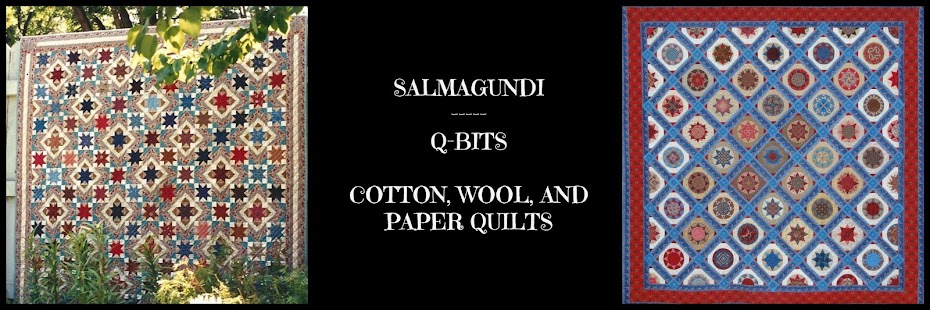I'm ready for something I haven't done for a couple of years that is always a challenge -- a medallion quilt. I like the "design as you go" format with no preconceived pattern. Additionally being a frugal soul, I wanted a project to use my scraps. I did purchase two fat quarters on sale for $2.00 each, and used pieces of leftover batting and a piece of fabric for the back that I had purchased as a souvenir in Maine in 1992. It feels good to be thrifty, using what I have, and stretching my creativity!
THE STATS: Medallion Mania, 2023, 25"x 25", Machine pieced, Machine quilted.

I was fortunate to be able to draw on my mathematical education early on in my quilting years, which prepared me to understand the basis of geometry. Plus, I had learned from my grandmothers the idea of being frugal in all things. Then, in the early 1980s I took two classes from Jinny Beyer on drafting designs and making patterns. I easily understood the math concepts that she was teaching, but the big take-away for me was her understanding of effective fabric and color choices. She has written comprehensive books about designing, pattern drafting, fabric and color theories, and the traditional concept and benefit of being in control of all steps of creativity. She was a great teacher and innovative pioneer of the resurgence of the interest in quiltmaking but still respectful of the past traditions.
I have followed the growth of the quilting industry over the years noticing the changes that have transpired. Traditionally a quilt was made in the interest of frugality with the bonus of being a creative outlet for the maker combining the process and the product. In the 1970s, the U.S. Bicentennial created a renewed interest in the making of quilts. At that time to supplement our scrapbags, we were finding 100% cotton fabric only from the local department stores and an occasional general fabric store. In the more metropolitan areas, stores specifically for quiltmakers were starting to spring up along with the publishing of more magazines and books for the quiltmaker. In the 1980s, it became a big industry with state and national symposiums with recognized designers, teachers, and businesses. That has grown into the modern era of quiltmaking that we enjoy today.
We are now able to access a wonderful, diversive supply of fabrics and tools. In addition, the local quilting stores have now developed into a community to meet like-minded individuals to enjoy fellowship. It is enlightening to talk with the shoppers and staff to learn what they are making and see what is new in the market. My budget doesn't allow buying for speculation, so I am not a very profitable consumer. Usually I buy only small amounts of fabric for a planned project to be supplemented by my stash which consists of small leftover pieces of fabric. My gadget collection consists only of a 35-year-old rotary cutter and two rulers. However, I certainly applaud the ingenuity and success of those entrepreneurs and their welcoming attitude to all.
Quiltmaking has been an important part of my life for 70 years, and I often think about its future. Has the product now become more important than the process? Does the proliferation and availability of patterns, kits, laser-cut-by-machine pieces, and professional long-arm services stifle a part of the creativity, challenge, and fun of making a quilt under your own control from start to finish? Are there enough classes being taught to new quilters about the skills needed to follow the tradition of frugality and creativity? Will the skills used for drafting patterns, figuring out quilting designs, and choosing colors and fabrics be lost? Is this a skill-set that is best learned by experience?
I have no answers but if interested about old-school quiltmaking, I recommend Jinny Beyer's books entitled "Patchwork Patterns", "The Quilter's Album of Blocks and Borders", "Medallion Quilts", "The Scraplook", and "Color Confidence for Quilters". In the interest of frugality, start with your local library as the original copies have risen in value.
I thoroughly love what I do, and I hope you also enjoy your passion!







